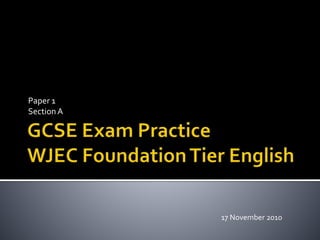
GCSE English Practice Exam Section A
- 1. Paper 1 Section A 17 November 2010
- 2. Please put your name on a piece of paper. At the end of the lesson, please give your answer to Louise to be marked. You have to handwrite your answer in the exam, so this is good practice.
- 3. You have 55 minutes to complete section A. There are 4 questions, each with 10 marks.
- 4. Read the extract. Read all 4 questions. How much time do you have left? Divide that time into four. You now have a time budget – you know how long to spend answering each question.
- 5. Before starting to write, try to decode the question. In question one, the examiner wants you to do three things: 1. Only use lines 1-23 2. Write about your first impressions of Laurie. 3. Use the text to support your answer.
- 6. Mark the lines you are to use (lines 1-23). Underline the keywords in the question (first impressions of Laurie). Mark any relevant words & descriptions in the extract.You could mark words such as refused/ cocky/ slamming, aggressive/shouted and also mark the things Laurie did such as spilling the baby’s milk.
- 7. My first impressions of Laurie are of a cheeky and defiant child. The first impression that the reader gets of Laurie is of a cocky child who refuses to do as his parents ask. The first thing we know about Laurie is that he refuses to wear what he’s told, giving us the impression that he is a naughty child.
- 8. Laurie does not behave well at home. As well as slamming the door, throwing his cap on the floor and spilling the baby’s milk. He ‘spoke rudely to his father.’ Both the words and the actions give us the impression that Laurie does not respect his parents. The words in italics are quoted from the text to support your answer.
- 9. Laurie does not behave well at home. As well as slamming the door, throwing his cap on the floor and spilling the baby’s milk. He ‘spoke rudely to his father.’ Both the words and the actions give us the impression that Laurie does not respect his parents. The text in bold is your analysis.That means that you are looking at the words in the story and saying what effect they have.
- 10. When you answer a question, try to follow a 3- point formula. 1. Point – you want to say that Laurie behaves badly at home. 2. Evidence – you use the text to support your answer. 3. Analysis – you say what you think the evidence shows.
- 11. 1.(Point) Laurie does not behave well at home. As well as slamming the door, throwing his cap on the floor and spilling the baby’s milk, 2. (Evidence) he ‘spoke rudely to his father.’ 3. (Analysis) Both the words and the actions give us the impression that Laurie does not respect his parents.
- 12. You have written one sentence and one paragraph so far. How much time do you have left? Another few minutes? Great!Write another 3- point paragraph. No time? Click to the next slide.
- 13. ‘My first impressions of Laurie are of a cheeky and defiant child. Laurie does not behave well at home. As well as slamming the door, throwing his cap on the floor and spilling the baby’s milk. He ‘spoke rudely to his father.’ Both the words and the actions give us the impression that Laurie does not respect his parents.’ You have one paragraph. Ideally you would write at least another two paragraphs on this answer – but if you have run out of time, leave a space (so that you can come back later if you have time at the end of the exam) and go on to the next question.
- 14. You will get some marks for a short answer. You will get no marks if you run out of time and don’t reach the last question. Remember to leave a space so that you can go back to unfinished questions if you have time at the end of the exam.
- 15. Before starting to write, ask yourself: How much time do I have? Which lines should I use? What words in the question should I underline? What words in the text will help me answer the question?
- 16. Look at the words you have underlined in the question. Make a sentence that uses those words.This tells the examiner that you have understood the question. Ask Louise to check your first sentence.
- 17. Decide what you want to say. Ask yourself: What did I learn about Charles? Find some evidence from the text that supports what you said that you learnt about Charles. ‘Charles bounced a seesaw onto the head of a little girl and made her bleed.’ Analyse or sum up your findings. Because the author lists all the bad things Charles did at school, we learn that he is a very difficult student.
- 18. You can do this one! It is very like questions 1 and 2. Use the same PEA formula.
- 19. Ask yourself what the examiner wants you to do? Underline the key words in the question. It’s a test of your understanding. Put the situation and the question into your own words: Laurie’s mother has just found out the truth. How is she going to tell her husband?
- 20. The key word is imagine. If you were Laurie’s mother, how would you explain that Charles is really Laurie? Can you imagine how she is feeling now she knows the truth?
- 21. Please hand in your paper for marking. Make sure your name is on your paper.
